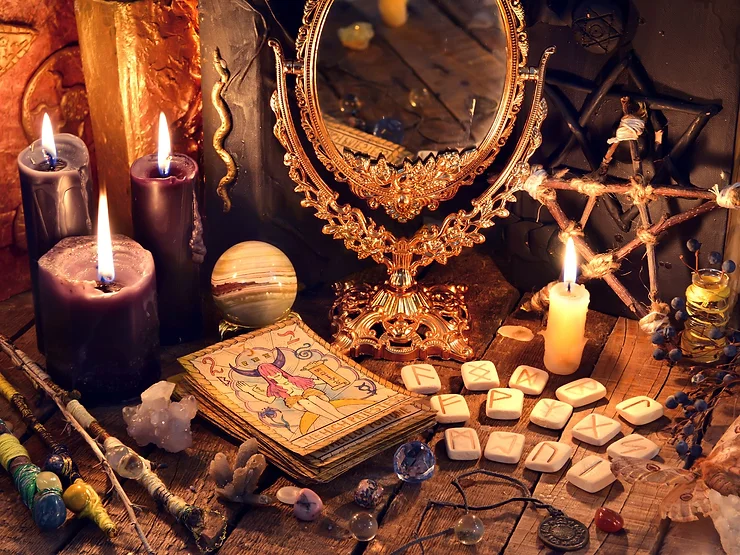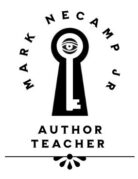
Part of the reason for creating this site and writing blog posts again (after not having a blog for several years), is to bring information to those that seek it. I was in a “male witch support group” (the importance of men’s groups will be a post for next month), and someone asked questions about tarot that I am sure other new seekers have. While I can go on about tarot, I wanted to actually talk about divination in general, since it is useful to get a background established before really diving into the specifics of a particular method.
We are curious, emotional, and sometimes practical creatures. We want to know what is happening, and what we can do about it. Divination is the spiritual art of finding information that is hidden from us. This could be information about the past, present, or future. It could be about love, money, death, or anything at all. Divination is a magickal art that is prevalent in almost every religion, culture and magickal school, and there are as many systems as there are cultures and time periods.
There are many different types of divination. It can be as simple to reading omens and signs in nature, like interpreting how the wind makes waves on water, or as complex as the divination systems of Africa where there are over 250 readings and each one is a teaching story. Tarot is one of the most popular tools of divination, but it is not the only one. The oldest ways to divine come from natural means. Reading entrails (haruspicina) has been used by Indigenous Cultures for thousands of years and there are various systems that use sticks (I-Ching), shells (dilogun), or stones (Runes) to make a reading. What makes a divination tool enduring over time is its flexibility to potentially find any answer, but also how it connects to the practitioner.
What makes these systems work is that they are mental maps (psychocosms) that are overlaid on the terrain of the Universe and our personal consciousness (which are really the same thing). An old teacher of mine said many times- “do not confuse the map with the terrain”. This means that while any system of divination or magick can be used to observe, interpret, and manipulate your self or the world; it is not the thing itself. This is why many different systems exist and why some are useful for some purposes and not others. Each piece in a system of divination is a representation of a piece of the wider world and ourselves. For example, the rune Mannaz can represent human intelligence in the Norse divination system. When we get a divination reading, we are getting a representation of the state of the Universe at that time; or at least our part of it and how we relate to it.
The success of divination comes from the ability of the practitioner to do a few key things. They must be somewhat of an open channel to receive that information, have knowledge of the system that information is being transcribed to, and the intuition to interpret that knowledge effectively to discern what is accurate and true information. This information can come from almost any source; the subconscious of the person being read, gods, spirits, ancestors, or something deeper, larger and more transcendental. Knowledge of a divination system comes from initial study and memorization of the symbols in that system, but also from experience. This experience is gained from what the reader has received in the past through doing readings over time, but also from lore and stories from other diviners. Intuition comes from training and discipline. A training regimen could include mediation, psychic exercises, ritual, and other spiritual work.
Divination is a snapshot of the Universe. We can see this in things such as astrology (probably the most popular form of divination) when someone gets a reading of their birth chart- which is a snapshot of the sky when you were born- or even when we read our horoscope which is interpreting the snapshot of the heavens in the present and how that relates to you. In astrology, the various planets are not just physical bodies in the heavens, they are psychic structures that influence and represent parts of who we are. Venus can be interpreted as love and how we love. The Sun is our identity and ego. It goes on and on. The external sky and the cosmology of the self are mirrored. This brings us to one of the most important spiritual concepts in Western magick and spirituality- “as above, so below”- the microcosm (“little world”) and the macrocosm (“large world”) are reflections of each other.
Right now, I am really focused on systems that work because they are reflections of the Universe. One can get the information they seek from things such as scrying (using objects to get symbols or images directly) or even speaking with non-corporeal entities such as angels, spirit guides, or the mighty dead. These systems require more practice and discipline to avoid the pitfalls of them. That being said, I find them very useful and one should master as many spiritual tools as they can.
So, divination is used to get information in a spiritual manner, every system should be a reflection of the world we are trying to get that information from, and a reading is a snapshot of that world. This leaves us with two questions- how to take that snapshot, and how to understand it.
To do a reading, you need to choose a method, but there are typically two main components; the layout and the objects in that layout. For example, when someone does a tarot reading there are various cards that can be laid out in a certain manner. For example, in a 3 card reading the past, present, and future, with a card for each time frame. A Death card in the future might mean that drastic, personal change is on the way.
Each layout can be used as a filter for the various forces and objects from the system of divination. Layouts can be as simple or complex as needed. You can use established ones, or make your own. If you are researching tarot, you may find popular layouts like the Celtic Cross for a general reading or even astrological readings, where 12 cards are laid out in a circle to represent the various astrological houses that rule different aspects of human existence.
Interpreting the information takes skill. The steps of the standard reading can be as follows:
- Preparation. Before any reading, the practitioner should do some work to relax, unless they are already fairly relaxed or have trained to relax quickly. This is important so that the information that flows is outside of yourself and your own personal thoughts, worries, information are not being projected onto the reading. This is also important so that there is not an “afterglow” from one reading to another if you are doing multiple readings. Some people like to purify the space they are reading in, as well as the reader, and sometimes the person getting the reading,
- Opening. When you are relaxed, shuffle your objects, and place them with as little conscious thought as possible. Some readers like to have the person (querent) getting the reading to hold the divinatory tools to get their energy in the objects as a way of tuning the reading even more to that person. This is not necessary, but it can be useful especially when you are starting out. It is important to “clear” the objects (cards, reuns, etc) between readings so that each reading does not influence the next. This is both a psychological and magickal exercise. The shuffling of the cards also helps in this reset process and some people like to shuffle after a reading as well to further clear the divinatory tools.
- Layout. Lay out the divination objects in a predetermined layout. Research into that layout should be done beforehand. Memorization of the layout, and the divination system help tremendously. Starting out it is ok to use the books as a guide until you have more understanding, and have internalized and integrated the system more.
- Interpretation. This is based on pre-established knowledge (experience//books/guides/etc) combined with intuition. There are multiple correspondences and interpretations of each object and your intuition should be used to filter which meaning is the most accurate. For example the 5 of Swords cards in Tarot could be interpreted as competition, but also conflict, or success achieved through dishonest means. The way to discern which aspect of the card is correct, is to use your intuition to choose the aspect of that card that feels the most relevant, as it pertains to where it is in the layout. Sometimes it is good to take notes starting out to keep track of what you interpret, to add to your personal mental library of how you specifically work with that system.
- Closing. Check to see if there are any questions. This is a time to give clarification to the querent. Also, if more information is needed to get that clarification, you can draw additional runes,cards, etc to flesh out the initial interpretation with more details. After the reading is done, thank the energies that came through. Collect your divinatory tools. Shuffle as needed, if you wish, and do any after care you feel is appropriate. Aftercare could include drinking tea, grounding, or just putting your tools away.
I hope this gives a good overview on what divination is and some basics on use. If there are any questions, please feel free to contact me via social media or this site.
Blessings.
